United Nations / Electronic Data Interchange for Administration, Commerce and Transport - UN/EDIFACT | 12th Computer Applications : Chapter 18 : Electronic Data Interchange (EDI)
Chapter: 12th Computer Applications : Chapter 18 : Electronic Data Interchange (EDI)
UN/EDIFACT
UN/EDIFACT
United Nations / Electronic Data Interchange for
Administration, Commerce and Transport (UN / EDIFACT) is an international EDI -
standard developed under the supervision of the United Nations.
In 1987, the UN / EDIFACT syntax rules were
approved as ISO: ISO9735 standard by the International Organization for
Standardization. See Figure 18.4
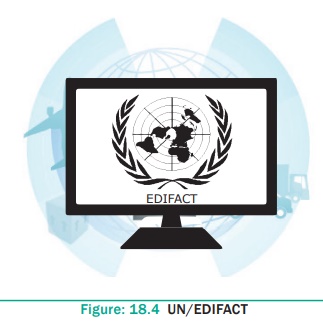
EDIFACT includes a set of internationally agreed standards, catalogs and guidelines for electronic exchange of structured data between independent computer systems.
It is a cross-industry, standard data format of
electronic data for commercial transactions. Maintenance and further
development of this standard goes through the United Nations Center for Trade
Facilitation and Electronic Business (UN/CEFACT), which is affiliated to the UN
Economic Commission for Europe (UNECE).
EDIFACT directories
The versions of EDIFACT are also called as
directories. These EDIFACT directories will be revised twice a year; on 1st
April and 1st October to include new or update existing EDIFACT messages.
EDIFACT directories have names like D.18B
(D stands for Directory, 18 is the year and A/B
indicates the month of release)
EDIFACT subsets
Due to the complexity, branch-specific subsets of
EDIFACT have been developed. These subsets of EDIFACT include only the
functions relevant to specific user groups.
Example:
CEFIC - Chemical industry
EDIFURN - furniture industry
EDIGAS - gas business
EDIFACT Structure
EDIFACT is a hierarchical structure where the top
level is referred to as an interchange, and lower levels contain multiple
messages. The messages consist of segments, which in turn consist of
composites. The final iteration is a data element. See Figure 18.5 and 18.6
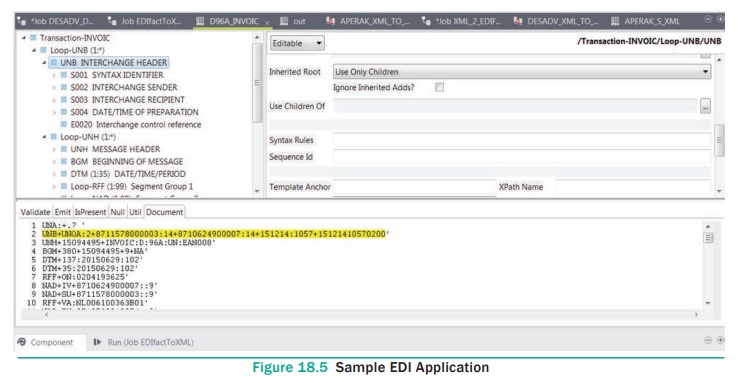
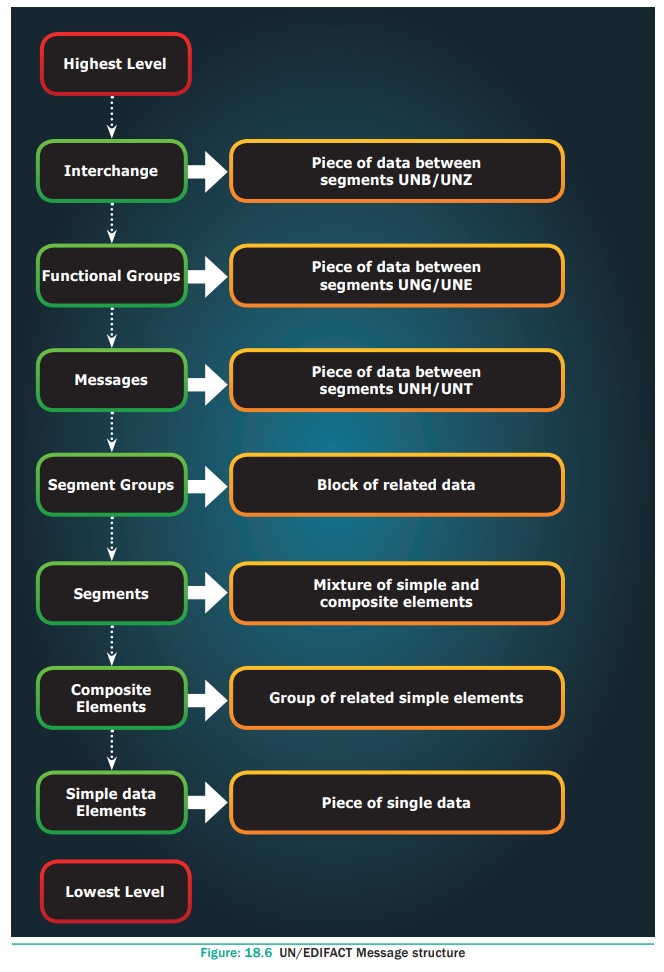
Segment Tables
Segment table lists the message tags. It contains
the tags, tag names, requirements designator and repetitation field. The requirement
designator may be mandatory (M) or conditional (C). The (M) denotes that the
segment must appear atleast once. The (C) denotes that the segment may be used
if needed. e.g. C10 indicates repetitions of a segment or group between 0 and
10.
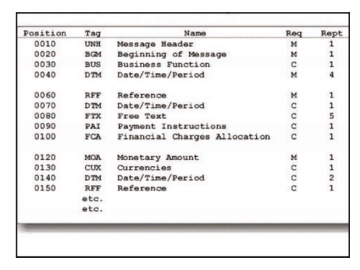
EDI Interchange
Interchange is also called as envelope. The top level of EDIFACT structure is Interchange. An interchange may contain multiple messages. It starts with UNB and ends with UNZ
EDIFACT message
The basic standardization concept of EDIFACT is
that there are uniform message types called United Nations Standard Message
(UNSM). In so-called subsets, the message types can be specified deeper in
their characteristics depending on the sector. The message types, all of which
always have exactly one nickname consisting of six uppercase English alphabets.
The message begins with UNH and ends with UNT
● Service messages
To confirm / reject a message, CONTRL and APERAK
messages are sent.
❍ CONTRL- Syntax
Check and Confirmation of Arrival ofMessage
❍ APERAK -
Technical error messages and acknowledgment
● Data exchange
❍ CREMUL -
multiple credit advice
❍ DELFOR-
Delivery forecast
EDIFACT Segment
It is the subset of message. A segment is a
three-character alphanumeric code. These segments are listed in segment tables.
Segments may contain one, or several related user data elements.
EDIFACT Elements
The elements are the piece of actual data. These data elements may be either simple or
composite.
An excerpt from an EDIFACT message
might be:
DTM + 11: 200 606 200 730: 203’
This whole line is called a segment.
The meaning of each code is as follows:
● DTM is the segment identifier and
it indicates that the following data is date / time information.
● 11 is a data element. In this
example, a qualifier describes what kind of event is meant. The code 11 means:
time of dispatch / delivery of goods.
● 200606200730 is another element.
Here it represents the date in the format CCYYMMDDHHMM.
● 203 is also an element. 203 is an
identifier for the date format.
In this example, 203 means that the
date is in the format CCYYMMDDHHMM (as of D.18B, CC – century, YY – Year, MM-
Month, DD – Date, HH – Hour, MM – Minute)
EDI Separators
EDIFACT has the following punctuation marks that
are used as standard separators.
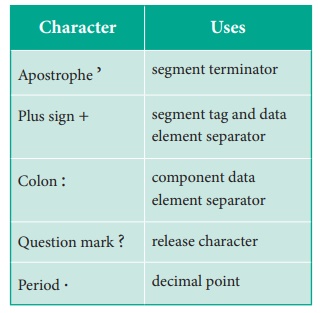
Example:
UNA:+.? ‘
UNB+IATB:1+6XPPC:ZZ+LHPPC:ZZ+940101:0950+1’
UNH+1+PAORES:93:1:IA’
MSG+1:45’
IFT+3+XYZCOMPANY AVAILABILITY’
ERC+A7V:1:AMD’
IFT+3+NO MORE FLIGHTS’
ODI’
TVL+240493:1000::1220+FRA+JFK+DL+400+C’
PDI++C:3+Y::3+F::1’
APD+74C:0:::6++++++6X’
TVL+240493:1740::2030+JFK+MIA+DL+081+C’
PDI++C:4'
APD+EM2:0:1630::6+++++++DA’
UNT+13+1’
UNZ+1+1’
Related Topics